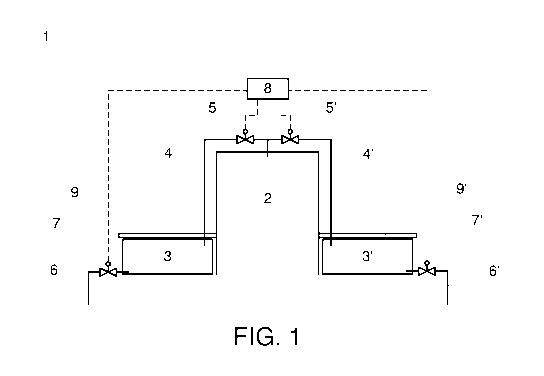Some of the information on this Web page has been provided by external sources. The Government of Canada is not responsible for the accuracy, reliability or currency of the information supplied by external sources. Users wishing to rely upon this information should consult directly with the source of the information. Content provided by external sources is not subject to official languages, privacy and accessibility requirements.
Any discrepancies in the text and image of the Claims and Abstract are due to differing posting times. Text of the Claims and Abstract are posted:
| (12) Patent Application: | (11) CA 2915715 |
|---|---|
| (54) English Title: | FLOATING CONSTRUCTION |
| (54) French Title: | CONSTRUCTION FLOTTANTE |
| Status: | Deemed Abandoned and Beyond the Period of Reinstatement - Pending Response to Notice of Disregarded Communication |
| (51) International Patent Classification (IPC): |
|
|---|---|
| (72) Inventors : |
|
| (73) Owners : |
|
| (71) Applicants : |
|
| (74) Agent: | SMART & BIGGAR LP |
| (74) Associate agent: | |
| (45) Issued: | |
| (86) PCT Filing Date: | 2013-06-19 |
| (87) Open to Public Inspection: | 2014-12-24 |
| Availability of licence: | N/A |
| Dedicated to the Public: | N/A |
| (25) Language of filing: | English |
| Patent Cooperation Treaty (PCT): | Yes |
|---|---|
| (86) PCT Filing Number: | PCT/FI2013/050669 |
| (87) International Publication Number: | WO 2014202820 |
| (85) National Entry: | 2015-12-16 |
| (30) Application Priority Data: | None |
|---|
7Abstract A floating construction (1) comprising a container (2) filled fully or partially with water, the lower portion of the container being located within a surrounding body of water and the water surface level of the surrounding body of water be- ing substantially lower that the water surface level inside the container, the container comprising transparent walls or walls with transparent sections and at least one open opening for entering the container, which at least one open opening is located below the surface level of the surrounding body of water, and which floating construction comprises space (9) for spectators observing activities taking place inside the container, wherein the floating construction (1) comprises at least one ballast tank (3, 3'), which ballast tank is connected to the container (2) with a controllable pressure connection (4, 5, 4', 5'), and which ballast tank has controllable water connection (6, 7, 6', 7') to the surrounding body of water.
L'invention concerne une construction flottante (1) comprenant un contenant (2) entièrement ou partiellement rempli d'eau, la partie inférieure du contenant étant située dans un corps d'eau environnant et le niveau de surface d'eau du corps d'eau environnant étant sensiblement inférieur au niveau de surface d'eau à l'intérieur du contenant, le contenant comprenant des parois transparentes ou des parois ayant des sections transparentes et au moins une ouverture ouverte pour entrer dans le contenant, au moins une ouverture ouverte étant située au-dessous du niveau de surface du corps d'eau environnant, et laquelle construction flottante comprend un espace (9) pour des spectateurs observant des activités ayant lieu à l'intérieur du contenant, la construction flottante (1) comprenant au moins une citerne de ballast (3, 3'), laquelle citerne de ballast est reliée au contenant (2) au moyen d'un raccordement pression pouvant être commandé (4, 5, 4', 5'), et laquelle citerne de ballast a un raccordement eau pouvant être commandé (6, 7, 6', 7') au corps d'eau environnant.
Note: Claims are shown in the official language in which they were submitted.
Note: Descriptions are shown in the official language in which they were submitted.

2024-08-01:As part of the Next Generation Patents (NGP) transition, the Canadian Patents Database (CPD) now contains a more detailed Event History, which replicates the Event Log of our new back-office solution.
Please note that "Inactive:" events refers to events no longer in use in our new back-office solution.
For a clearer understanding of the status of the application/patent presented on this page, the site Disclaimer , as well as the definitions for Patent , Event History , Maintenance Fee and Payment History should be consulted.
| Description | Date |
|---|---|
| Inactive: IPC expired | 2020-01-01 |
| Application Not Reinstated by Deadline | 2019-06-19 |
| Inactive: Dead - RFE never made | 2019-06-19 |
| Inactive: Abandon-RFE+Late fee unpaid-Correspondence sent | 2018-06-19 |
| Change of Address or Method of Correspondence Request Received | 2018-01-12 |
| Inactive: Cover page published | 2016-02-17 |
| Inactive: Notice - National entry - No RFE | 2016-01-04 |
| Application Received - PCT | 2016-01-04 |
| Inactive: First IPC assigned | 2016-01-04 |
| Inactive: IPC assigned | 2016-01-04 |
| Inactive: IPC assigned | 2016-01-04 |
| Inactive: IPC assigned | 2016-01-04 |
| National Entry Requirements Determined Compliant | 2015-12-16 |
| Application Published (Open to Public Inspection) | 2014-12-24 |
There is no abandonment history.
The last payment was received on 2018-05-23
Note : If the full payment has not been received on or before the date indicated, a further fee may be required which may be one of the following
Please refer to the CIPO Patent Fees web page to see all current fee amounts.
| Fee Type | Anniversary Year | Due Date | Paid Date |
|---|---|---|---|
| MF (application, 2nd anniv.) - standard | 02 | 2015-06-19 | 2015-12-16 |
| Basic national fee - standard | 2015-12-16 | ||
| MF (application, 3rd anniv.) - standard | 03 | 2016-06-20 | 2016-05-20 |
| MF (application, 4th anniv.) - standard | 04 | 2017-06-19 | 2017-05-23 |
| MF (application, 5th anniv.) - standard | 05 | 2018-06-19 | 2018-05-23 |
Note: Records showing the ownership history in alphabetical order.
| Current Owners on Record |
|---|
| WATERBOX OY |
| Past Owners on Record |
|---|
| JUHA SAARANEN |